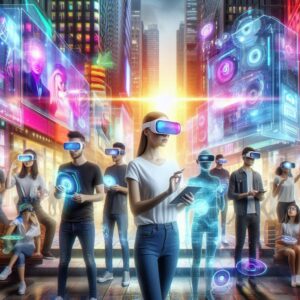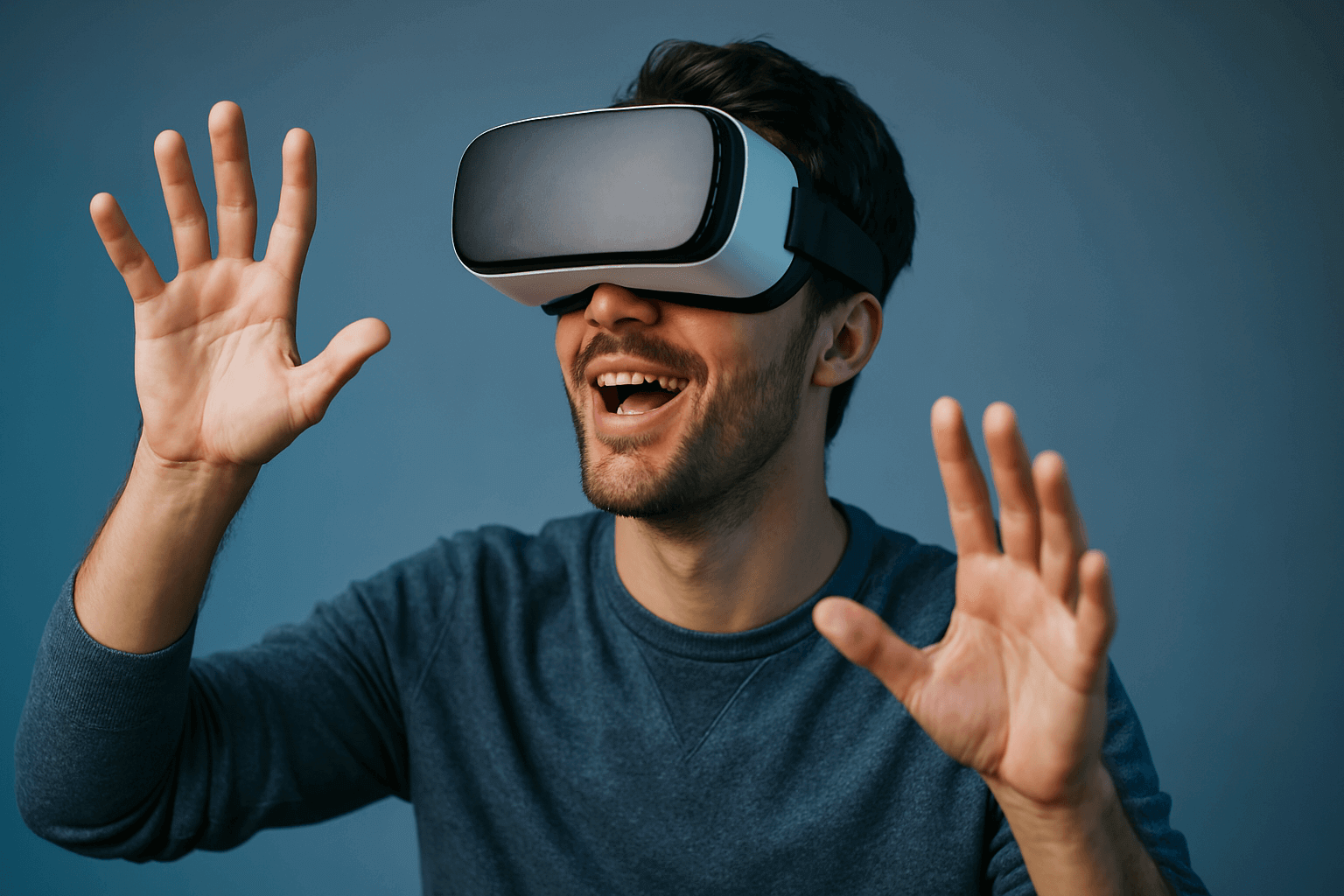Marketing is constantly evolving, and today’s brands must find innovative ways to capture consumer attention in a competitive digital landscape. Among the most transformative developments in recent years are augmented reality AR and VR in marketing. These cutting-edge technologies open up new possibilities for creating immersive, interactive experiences that go far beyond traditional advertisements. In this article, we explore what AR and VR are, how they work, and why they are becoming essential tools for brands looking to build deeper connections with their audiences.
Augmented reality is a technology that overlays digital content onto the real world using everyday devices such as smartphones, tablets, or specialized glasses. When you use an AR app on your phone, you might see animated effects on your face or view a piece of furniture virtually placed in your living room. In marketing, AR has become a powerful tool by allowing brands to create interactive experiences that merge digital content with physical surroundings.
What Is Augmented Reality (AR) in Marketing?
AR in marketing can be seen in several ways. Customers can see how a product fits into their daily lives—imagine a furniture retailer offering an AR app that lets users place a virtual sofa in their living room before making a purchase. AR is also used for virtual try-ons in the beauty and fashion industries, where consumers can experiment with makeup or clothing styles without visiting a store. Additionally, brands are enhancing product packaging by integrating AR experiences that deliver interactive content when a smartphone is pointed at a package.
What Is Virtual Reality (VR) in Marketing?
Virtual reality, by contrast, creates a fully immersive digital experience by replacing the user’s real-world environment with a computer-generated one. Accessing VR typically requires a headset, which transports users into a completely different world. This technology is particularly valuable for experiences that benefit from full immersion. For example, automotive companies may offer virtual showrooms where prospective buyers can take a “test drive” from home, or travel brands may create virtual tours of exotic destinations that make the viewer feel as if they are really there. VR is also used to tell brand stories in a way that connects with viewers on an emotional level. With VR, a user is no longer just reading about a product or watching a conventional video—they are actively participating in a narrative.
Differences Between AR & VR in Marketing
Understanding the differences between AR and VR is crucial when deciding which technology best suits your marketing goals. AR offers partial immersion by blending digital elements with the real world and is accessible on devices that many people already own, making it easier to implement and reach a broader audience. On the other hand, VR provides complete immersion by creating a virtual environment that fully replaces the user’s current surroundings. This level of immersion is ideal for storytelling or for experiences where undivided attention is necessary, but it often requires specialized hardware that can limit its immediate reach. While AR tends to be less expensive and simpler to deploy, VR demands a higher investment in terms of technology and development. Yet, each offers unique benefits that can help a brand stand out.
The importance of AR and VR in today’s marketing landscape cannot be overstated. In an era when consumers are bombarded with countless advertisements, traditional methods often fail to engage the modern audience. AR and VR break through this clutter by offering interactive experiences that capture attention and hold it. These technologies not only provide visual novelty but also foster deeper emotional connections with the brand. When consumers engage with an AR or VR experience, they become active participants rather than passive viewers. This increased engagement often leads to higher recall and stronger loyalty, which are critical in today’s highly competitive markets.
One of the most compelling aspects of AR and VR in marketing is their ability to transform customer engagement. With interactive experiences, consumers are invited to participate in ways that traditional ads simply cannot match. Instead of merely watching a product on a screen, users can manipulate 3D models, explore virtual environments, or even play gamified experiences that reward them with discounts or special offers. For example, a retail brand might develop an AR-powered interactive window display that allows passersby to view additional product information or watch a short video by scanning a QR code with their smartphone. These interactions not only create excitement but also help to educate the consumer about the product in an engaging manner.
Why AR and VR in Marketing Matter Today
Virtual try-ons represent another major breakthrough enabled by AR. In the fashion and beauty industries, virtual try-on applications have revolutionized the shopping experience. Consumers can now see how a pair of glasses fits their face, test various makeup shades, or even try on a new outfit without stepping into a fitting room. This digital trial process significantly reduces the uncertainty of online shopping. When consumers can see a realistic simulation of how a product looks on them or in their space, they are more confident in their purchasing decisions. This boost in consumer confidence often translates to higher conversion rates and a decrease in product returns.
Transforming Customer Engagement with AR and VR
Beyond individual product interactions, AR and VR are also transforming the way brands tell their stories. Immersive storytelling through VR allows companies to create entire narratives around their products. Rather than simply listing features or benefits, a brand can take the consumer on a virtual journey that highlights its values and heritage. A travel agency, for instance, might offer a VR tour of an exotic destination, complete with interactive elements that provide insights into local culture, cuisine, and attractions. Such an immersive experience creates a powerful emotional connection that is far more memorable than traditional advertising. For more insights on how immersive technology is revolutionizing marketing, you can read this in-depth article on Forbes.
Immersive Storytelling and Gamification in Marketing
Gamification is yet another innovative application of AR in marketing. By incorporating game elements—such as challenges, rewards, and point systems—into marketing campaigns, brands can encourage consumers to interact with their products in a fun and engaging way. AR-powered games have proven particularly effective at capturing attention and boosting brand awareness. For example, a popular mobile game might include branded challenges or rewards that are accessible only through an AR experience, generating buzz and encouraging social media sharing.
Data-Driven Personalization with AR and VR
The integration of data-driven personalization into AR and VR experiences is one of the most exciting developments in this field. Every interaction within an AR or VR experience generates valuable data about consumer preferences and behavior. This data can be analyzed to tailor future marketing efforts to individual users. For instance, if a consumer frequently interacts with a particular style or product in a virtual try-on application, the brand can use this information to provide personalized recommendations or targeted promotions. This level of customization not only improves the consumer experience but also increases the likelihood of conversions.
Real-World Success Stories in AR & VR Marketing
Several brands have successfully integrated AR and VR into their marketing strategies, setting new industry standards. IKEA’s AR app, IKEA Place, allows customers to visualize furniture in their own homes by overlaying 3D models in real time. This application has dramatically changed the way consumers shop for furniture by reducing the uncertainty of product dimensions and design compatibility. Similarly, Sephora’s Virtual Artist app uses AR to let users try on makeup virtually, making the decision process easier and more enjoyable. Nike has also embraced VR by creating immersive experiences that allow customers to engage with its brand in innovative ways, from virtual training sessions to interactive product demonstrations.
Social media platforms have become fertile ground for AR marketing. Snapchat and Instagram, for instance, offer AR filters that enable users to transform their appearance or surroundings with branded effects. These filters are not only entertaining but also serve as powerful tools for brand exposure, as users share their augmented images with friends and followers. Amazon’s AR View is another example that demonstrates how AR can bridge the gap between online and offline shopping by allowing customers to preview products in their own environment before making a purchase. For a broader perspective on AR and VR trends in marketing, check out this report by Marketing Dive.
Overcoming Challenges in AR and VR Marketing
Despite the numerous benefits of AR and VR in marketing, there are challenges that brands need to address. One of the primary challenges is the high development cost. Creating high-quality AR and VR experiences often requires significant investment in technology, skilled developers, and sophisticated content creation. To manage these costs, many brands are starting with simpler, browser-based solutions known as WebAR, which do not require dedicated applications or expensive hardware. Another challenge is user adoption. While many consumers are excited by the potential of AR and VR, others may be hesitant or unfamiliar with the technology. This gap can be bridged by designing intuitive user interfaces, offering clear instructions, and even providing in-store demonstrations to show the value of these experiences.
Device compatibility is another concern, particularly for VR, which often requires specialized hardware that not all consumers possess. To maximize reach, many marketers are focusing on mobile-friendly AR experiences that run on devices most people already have. Data privacy and security are also critical issues; since AR and VR experiences often collect sensitive user data, brands must ensure that they follow strict privacy guidelines and protect consumer information with robust security measures.
The Future of AR and VR in Marketing

Looking ahead, the future of AR and VR in marketing is incredibly promising. The concept of the metaverse—a fully immersive, shared digital space—is beginning to gain traction, offering brands even more opportunities to create interactive storefronts, host virtual events, and develop campaigns that seamlessly blend digital and physical worlds. Additionally, the integration of artificial intelligence with AR and VR will enable real-time, hyper-personalized experiences. Imagine a virtual shopping assistant that uses real-time data to offer customized product recommendations or a VR experience that adapts to the user’s emotional responses. These innovations will further blur the lines between online and offline experiences, making immersive technologies an integral part of modern marketing strategies.
As more consumers embrace these technologies, the applications of AR and VR will continue to expand beyond marketing. These immersive tools are already being used for employee training, internal communications, and product demonstrations within companies. By simulating real-world scenarios, VR can provide a cost-effective and engaging way to train employees, while AR can enhance everyday tasks by overlaying useful information in real time.
Getting Started with AR and VR in Marketing
For brands looking to get started with AR and VR marketing, a strategic approach is essential. First, define clear objectives—whether that’s boosting brand awareness, increasing online sales, or improving customer engagement. Understanding your audience is crucial, so conduct research to assess their familiarity and comfort with these technologies. Choose the right platform for your goals, whether it’s a dedicated app, a social media integration, or a browser-based solution like WebAR. Starting small with a pilot project can help you gather valuable feedback before scaling up. Collaboration with experts or specialized agencies can further ensure that your project is executed with high quality.
Measuring performance is key to refining your strategy. Establish clear metrics—such as engagement rates, conversion rates, and customer feedback—to track the success of your AR or VR campaign. Continuous optimization based on data will help you maximize the impact of your immersive marketing efforts. Finally, staying updated on the latest trends and technological advancements in AR and VR will ensure your brand remains competitive and innovative.
Conclusion
In conclusion, augmented reality and virtual reality are reshaping the landscape of modern marketing by offering unique, immersive experiences that captivate consumers and build lasting emotional connections. Whether through virtual try-ons that boost purchase confidence, immersive storytelling that transports users into a brand’s universe, or interactive experiences that drive customer loyalty, AR and VR provide powerful tools to differentiate your brand in an oversaturated market. While challenges such as high development costs and limited user adoption exist, the benefits—from increased engagement and conversions to enhanced brand recall—make these technologies a worthwhile investment.
Brands that embrace AR and VR today are not just adopting innovative marketing strategies—they are positioning themselves as leaders in the digital age. As these technologies continue to evolve and integrate with other digital trends, such as artificial intelligence and the metaverse, their role in marketing will only become more central. The future of marketing lies in creating immersive, interactive, and highly personalized experiences, and AR and VR are at the forefront of this transformation.
How do you see AR and VR shaping the future of marketing? Are you ready to embrace the immersive revolution and transform your brand’s customer experience? The opportunities are vast, and the time to act is now. With careful planning, creative execution, and a willingness to innovate, your brand can harness the power of AR and VR to capture attention, engage consumers on a deeper level, and drive long-term success. Also Read About: Why Starbucks Marketing Strategy is So Addictive






